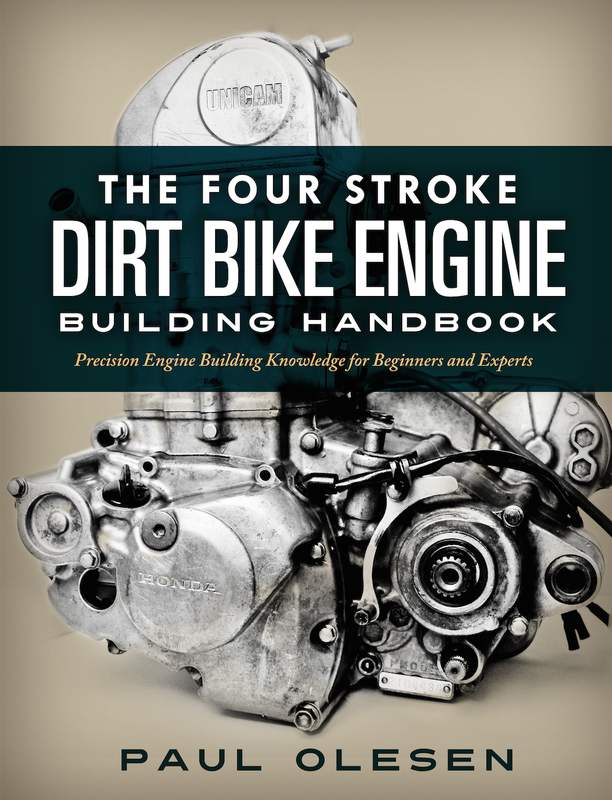|
I like to compare building an engine to performing open heart surgery. The precision and organization that goes into open heart surgery is exactly the mindset you need as you begin to rebuild your engine. Just like an operating room, I require my workspace to be as clean as possible. In the industry, companies have dedicated rooms just for engine building. These rooms are equipped with dust management systems, precise temperature control, and spotless work surfaces. I don’t expect the home mechanic to have this intense of a setup, but you should aim to have the cleanest work area possible.
How To Use Measurement Tools
It’s finally time! Hopefully from last week’s post you are beginning to feel like you have an understanding of the world of measuring and are ready to start working with the tools. In this post I will be covering four of the ten types of measuring tools you are most likely to encounter when rebuilding a dirt bike engine. Next week I will cover the remaining six tools.
Each measurement tool in this post features a description of appropriate applications for the tool and a step-by-step tutorial on how to use it. If you want all this info in one place, we compiled all three posts into a free downloadable guide for you. Click to download your copy of The At-Home Mechanic's Guide To Precision Measurement. This guide is designed as a reference so that you can easily come back to it at any time as you become more comfortable using measurement tools during a rebuild. As I mentioned in last week’s post, make sure your measurement tools are at room temperature prior to measuring. If you brought your tools from a warmer or colder room they will need time to adjust to the temperature... 
How much does a full engine rebuild cost you when you do it on your own? This is a question I see come up a lot in the forums, so I decided to address it again. You can check out an incredibly in-depth post on comparing what shops charge versus doing it yourself by clicking here. Otherwise read on for a great run down of what a full four stroke dirt bike engine rebuild in your own garage costs.
When you are using all OEM parts, which includes all new bearings throughout the engine, a cylinder head (reconditioned or new), new valvetrain, new crank, new piston, new cam chain and tensioner, and a freshly honed cylinder, the cost comes out to be between $1300 and $1500. If some aftermarket parts are utilized, the total cost will be around $300 less than the previously mentioned. Compare that price to $2000+ when you have a shop take care of it. Then add in the fact that when you rebuild yourself, you don't have to worry about someone else mishandling your bike or carelessly assembling your motor. When rebuilding your dirt bike engine yourself, you will know that the job was done correctly and meticulously. Another thing to consider is that once you learn how to rebuild an engine correctly, this knowledge will forever extend the life of your bike(s) and your bank account. How about the cost of a top end overhaul in your own garage? This could run you as little as $260 for a piston replacement, which includes a new piston, rings, circlips, head and base gaskets, and a freshly honed cylinder. Pretty inexpensive right? On the flip side a severely worn out top end which needs every bell and whistle replaced, aka the cylinder, the head, and valvetrain components could cost you $900 in OEM parts plus any machine work that must be done on the head or cylinder. Again, compare this to the $950 to $1500+ range for an in-shop piston replacement. These at-home mechanic perks are completely dependent on you putting the bike together correctly though, because if you don’t it can cost you big time. I read horror stories all the time on forums about guys who have built engines, but by the second or third ride they have grenaded. Most blame the parts, but more often than not the unpleasant truth is that assembly error and lack of attention to detail are the culprits. When I first started tearing into my own bike I made a lot of mistakes that I wish I could have avoided because it did end up costing me in the long run. Looking back now on those rookie rebuilds, after my education as a powertrain engineer and having designed and built an entire motorcycle engine, there were so many things I could have avoided if I had more help. The only thing available to me back then was a factory service manual, but a service manual is only part of the puzzle. For someone who is just getting into the whole rebuild world the service manuals are great for referencing specifications and summarizing procedures. However, the service manuals don't identify key inspection points, tell you what to look for, or instruct on key techniques. Without having years of experience under your belt, you become susceptible to missing critical details and steps throughout the build. Let me add that trying to watch free how-to videos online is a mess as well. After watching as many of these free videos online that I could find, as a professional I wish I could warn at-home mechanics to beware. These videos are poorly made, the attention to detail is nonexistent, the information provided is spotty at best, and the mistakes that can be accrued from trying to reference them can be costly. So how do you learn to rebuild correctly? Once I started pursuing an education and career in the motorcycle industry, I finally learned how to rebuild dirt bike engines the right way. Before this time, I kept on wishing that I had a mentor who could teach me how to do everything correctly. By working with highly skilled and experienced engine builders and engineers on a vast array of different engines, I learned that attention to detail, technique, and understanding how parts interact are all important aspects of rebuilding a healthy engine. Another key to my rebuild success was having the right tools and taking the time to measure things precisely. As I began to rebuild engines more and more, I realized that there are steps in which you need to trust a professional to do the work. Things like cutting valve seats, installing new valve guides, and rebuilding crankshafts are a few examples. Luckily, even with these specialized jobs getting farmed out, over 90% of the rebuild work can be done right at home. This means you still end up saving a ton of money. So how do we bridge that gap for the riders who want to learn how to rebuild their own engines the right way and save themselves money? What if you could have an in-shop mentor?
There are a ton of riders out there who would love to do the work themselves and learn more about the rebuild process, if they could only find a credible source to learn from. That’s where DIY Moto Fix comes in.
My aim is to teach at-home mechanics who want to learn from a professional on how to rebuild their own engines to exceptional industry standards. I want to be that mentor for dirt bikers everywhere that I needed all those years ago. If you want to learn from a professional, fix your own bike, and get back to riding check out my two published books on rebuilding dirt bike engines. You will also find tons of free guides to help get you started. Below are two of my most popular guides to date, with over 5000+ downloads.
Click here for the entire list of free guides I offer and download until your heart's content. Thanks for reading, and best of luck with your next rebuild!
Originally posted on our ThumperTalk Blog.
This week I want to provide you with some in-depth knowledge on the world of precision measurement. As at-home mechanics who want to take their rebuilding skills to the next level, learning about precision measurement and how to properly use precision tools is the final frontier. This post comes right out of The Four Stroke Dirt Bike Engine Building Handbook the engine building book I just published for my fellow riders who want to bring their engine building skills into a professional realm in their own garage. Learn more about the handbook by clicking here. This post is part one of three that will cover the correct use and implementation of precision measurement tools when rebuilding your own engine. We also compiled all three parts into a free guide, The At-Home Mechanic's Guide To Precision Measuring. To learn more and download your free guide click here. |
InspirationsCategories
All
Archives
November 2022
Favorite Films |








